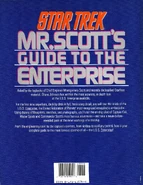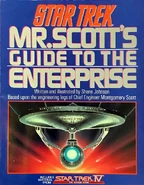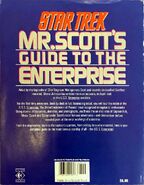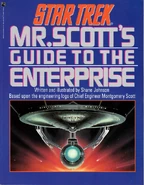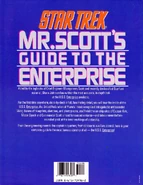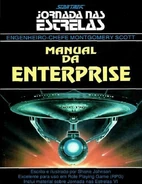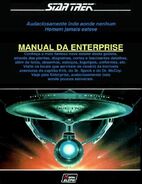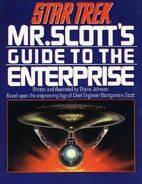(written from a Production point of view)
Mr. Scott's Guide to the Enterprise is an officially licensed technical manual of the Star Trek films-era Enterprise first published in 1987 by Pocket Books. Shane Johnson, who wrote and illustrated it, also wrote the prior unlicensed Star Fleet Uniform Recognition Manual which "The Noron Group" published in 1985. With some of the contents ported over to the Guide, it became in retrospect a companion volume devoted entirely to uniforms and other wardrobe.
The book was published as a follow-up for the Star Fleet Technical Manual and likewise written from an in-universe perspective, but it illustrated the retrofitted USS Enterprise and its replacement USS Enterprise-A. The book makes usage of the FASA naming and dating scheme, placing the vessel's refit in the early 23rd century.
Summary[]
- Publisher's blurb
- Mr. Scott's Guide to the Enterprise is the most accurate, in-depth look at the U.S.S. Enterprise™ NCC 1701A available. The Enterprise is thoroughly examined, deck-by-deck in full, fascinating detail. By using dozens of blueprints, sketches, and photographs, the inner workings of a starship are revealed.
- Excerpts of copyrighted sources are included for review purposes only, without any intention of infringement.
Contents[]
- Introduction, Written by Commander Montgomery Scott, chief engineer.
- History of refit
- General information
- Starfleet uniforms
- Uniform color codes
- Duty tunic
- Cadet/enlisted jumpsuit
- Rank insignia (Starfleet ranks)
- Service bars
- Typefaces
- Graphics labels
- Door insignia
- Departmental logos
- Shipboard symbols
- Starfleet uniforms
- Ship's layout
- A Deck
- Main bridge
- Docking port
- Contractor's sketches
- B-C Decks
- VIP facilities
- Meal Service
- Food processor unit
- D-E Decks
- VIP staterooms
- Junior officers' quarters
- Senior officers' quarters
- F Deck
- G Deck
- H-I Decks
- J-K Decks
- Main sensor array
- L-M Decks
- N-O Decks
- P-Q Decks
- R Deck
- S Deck
- Cargo deck
- T-U Decks
- A Deck
- Appendix: USS Enterprise (NCC-1701-A)
Background information[]
- A "Trekkie," or "Enterpriser," from the moment Star Trek: The Original Series made its resurgence in syndication, Johnson, like so many fans of the era, was huge fan of Franz Joseph (Schnaubelt)'s Star Trek Blueprints, the basis for the Star Fleet Technical Manual, whose contents Schnaubelt had also drawn, and he approached Pocket Books in 1985 with a proposal to draft a similar set based on the refitted USS Enterprise. Though the publisher declined his offer, it countered with the offer that he write a book instead, which eventually led to his first officially commissioned Star Trek title, Mr. Scott's Guide to the Enterprise. [1]
- The book was published shortly after the premiere of Star Trek IV: The Voyage Home, and hence Johnson was able to get some information derived from that film, aside from receiving input from long-time Star Trek production staffers Andrew Probert (co-designer of the refit-Enterprise) and Michael Okuda, who served as technical consultants on the book.
- A softcover, or paperback, book, it measured 11.2×8.7×0.7 inches. A near similarly sized hardback in dust jacket Book Club Edition was concurrently released in a substantial print run, though issued without ISBN as was commonplace for such releases. The paperback edition has seen one otherwise identical reprint under a new ISBN, and without the Voyage Home reference on the cover.
- The book was simultaneously released in the UK by Titan Books, albeit as a paperback edition only. Though the colophon listed the correct British ISBN, its back cover still featured the American one. It too saw a reissue in 2003, though it actually concerned the 1989 US reprint edition as import with a simple bar code sticker featuring the original UK ISBN placed over the American one – the contemporary solicitation cover notwithstanding, and as can be ascertained on the various online second-hand market places, such as eBay.
- Hungry for more works of the kind that Schnaubelt and David A. Kimble had created, fans were eagerly awaiting the release of the title, and the initial projected print run of 30,000 copies had to be increased to 60,000 copies, as advance sales had already exceeded the projected print run by the time the book was ready for release. Nevertheless, and while he was retained on a fixed fee, Johnson had already been warned by prior authors, including Schnaubelt and Kimble, that the franchise was not above shortchanging its contracted authors. And indeed, it was not till thirteen years after the first publication that Johnson received a first royalty statement – though still without a check enclosed. [2]
- The information in this manual was written in conjunction with some design staff of the movie series, and as such some of it is directly derived from filmed references, but some speculation within is outside of what is considered canon because some data is contradictory, as the nature of a continuing series is that new plot points may contradict previously assumed or unfilmed data.
- That being said, this manual was a valuable source of behind-the-scenes information. Many pieces of (black and white only) photography and behind-the-scenes graphics information used in filming are presented clearly here.
- According to the book (pp. 112, 114), an "Enterprise-class" starship named the USS Ti-Ho was built from the keel-up to test the first trans-warp drive. The ship was reportedly named in honor of a deceased friend of author Johnson, who was fond of the name. The book was dedicated to this friend. Incidentally, the conflicting Enterprise-class designation was introduced by Andrew Probert at the time of the production of Star Trek: The Motion Picture with the well-meant intention to differentiate the refit-configuration from its original (television) one, and actually popularized by its usage in the FASA RPG games. On another side note, Gene Roddenberry once suggested that the Enterprise-A was originally the USS Yorktown (Star Trek Encyclopedia (4th ed., vol. 2, p. 509)), and this reference appears in the Star Trek: The Next Generation Technical Manual.
- Discrepancies exist with some references to trans-warp drive being assigned to the USS Enterprise-A. Also, trans-warp drive is described as functioning by shifting a vessel so equipped through a spatial interphase into the parallel continuum in which the USS Defiant (NCC-1764) was lost in "The Tholian Web", then shifting it out of that continuum through another such interphase when emerging from trans-warp speeds.
- Despite having been fully licensed and endorsed at the time of the book's publication, the franchise has in 2002 re-evaluated the older in-universe reference works, hitherto considered as "semi-" or "quasi-canon". Works they deemed to have deviated too much from later established (on-screen) canon were subsequently demoted to the apocrypha status of comics, novels, non-production art (such as Star Trek: Ships of the Line calendars) and (computer)games. Like its Star Fleet Technical Manual predecessor, Mr. Scott's Guide to the Enterprise too was among those losing its "official" – as in compliance with canon – status, as indeed were all other books written by Johnson – as were those of his great example Joseph for that matter. (Star Trek: The Magazine Volume 2, Issue 11, p. 71)
- Nonetheless, Memory Alpha still considers some of the contents insofar that they had actually made on-screen appearances, especially where the photographs and the on-screen used graphics are concerned, as valid background information.
- At least one other international edition is known to exist, translated to Portuguese by Paolo Fabrizio Pugno and Ivo Luiz Heinz : the Engenheiro-Chefe Montgomery Scott Manual da Enterprise Brazilian paperback edition, released in 1993, likewise seeing several reprints afterward. [3] The Brazilian edition was recommended on the cover as an aid for Star Trek-themed RPG games, unsurprisingly perhaps, considering its usage of the FASA nomenclature.
References[]
Alpha Centauri; asparagus; Constitution-class; eggs Benedict; Enterprise, USS; Kalandan; light cube table; macaroni and cheese; pineapple; plomeek soup; potato salad; pot roast; Starfleet Academy; three-dimensional chess; titanium; transparent aluminum; trout amandine
See also[]
- Star Fleet Uniform Recognition Manual
- Star Trek Star Fleet Technical Manual
- Star Trek: The Next Generation Technical Manual
- Star Trek: The Next Generation Officer's Manual
- Star Trek: Deep Space Nine Technical Manual
- The Worlds of the Federation
External links[]
- Mr. Scott's Guide to the Enterprise at Memory Beta, the wiki for licensed Star Trek works
- Mr. Scott's Guide to the Enterprise at Wikipedia

